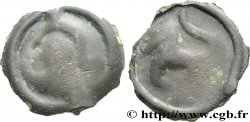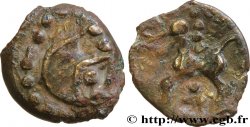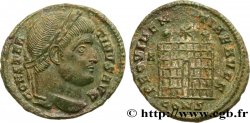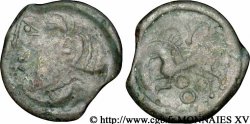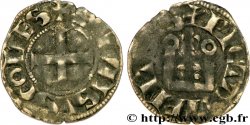v15_0410 - BITURIGES CUBI, INCERTI Bronze au cheval et aux trois annelets
MONNAIES 15 (2002)
Начальная цена : 138.00 €
Назначить цену : 250.00 €
непроданный лот
Начальная цена : 138.00 €
Назначить цену : 250.00 €
непроданный лот
Тип Bronze au cheval et aux trois annelets
Дата: c. 60-50 AC.
Металл: bronze
Диаметр: 17 mm
Ориентация осей монеты: 9 h.
Вес: 2,88 g.
Редкость: R2
Комментарии о состоянии
Beau portrait, revers complet entouré d’un bourrelet. Patine verte
Ссылки в каталоге: :
Лицевая сторона
Аверс: легенда: ANÉPIGRAPHE.
Аверс: описание: Tête stylisée à gauche, la chevelure en trois grosses mèches.
Обратная сторона
Реверс: легенда: ANÉPIGRAPHE.
Реверс: Описание: Cheval sexué, à gauche ; au-dessus, A renversé ; au-dessous, trois annelets posés deux et un.
Комментарий
Ces monnaies sont classées comme étant des bronzes, c’est à dire frappées. Cet exemplaire nous fait douter ; les traces de coulées de flan qui sont bien visibles peuvent être présentes sur des monnaies frappées, les flans étant obtenus par coulée. Mais le bourrelet qui entoure l’empreinte fait plutôt penser à un potin coulé dans un moule en creux. Cet exemplaire a la particularité de ne pas avoir la double ligne d’exergue présente sur les deux monnaies précédentes, et d’avoir les trois annelets placés à l’inverse ; deux et un au lieu de un et deux. L’exemplaire illustré à la page 468 de la RN 1908 a cette même particularité, mais la tête de l’avers est à droite (cf. MONNAIES XV n°413).
These coins are classified as bronzes, that is to say struck. This example makes us doubt; the traces of flan castings that are clearly visible may be present on struck coins, the flans being obtained by casting. But the bead that surrounds the impression is more reminiscent of a potin cast in a hollow mold. This example has the particularity of not having the double exergue line present on the two previous coins, and of having the three annulets placed in reverse; two and one instead of one and two. The example illustrated on page 468 of the RN 1908 has this same particularity, but the head on the obverse is on the right (cf. MONNAIES XV n°413)
These coins are classified as bronzes, that is to say struck. This example makes us doubt; the traces of flan castings that are clearly visible may be present on struck coins, the flans being obtained by casting. But the bead that surrounds the impression is more reminiscent of a potin cast in a hollow mold. This example has the particularity of not having the double exergue line present on the two previous coins, and of having the three annulets placed in reverse; two and one instead of one and two. The example illustrated on page 468 of the RN 1908 has this same particularity, but the head on the obverse is on the right (cf. MONNAIES XV n°413)








 Cообщить об ошибке
Cообщить об ошибке Распечатать страницу
Распечатать страницу Отправить мой выбор
Отправить мой выбор Задать вопрос
Задать вопрос Consign / sell
Consign / sell
 Информация
Информация


